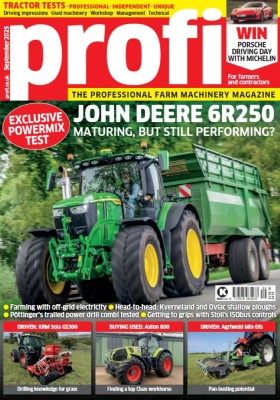We have been working with battery-powered Stihl split-shaft KMA 120R Kombi and Makita UX01G multi-tool units to power a range of attachments with two aims. First to see if battery power units can compare with petrol-alternative in terms of performance and second to compare battery systems compatible with workshop power tools and the ‘pro’ oriented Stihl ‘outdoor tool’ AP battery systems.
Split-shaft power units, that can operate attachments as diverse as line trimmers, pole saws, hedge cutters, through to brushes, water pumps and cultivators, have the key advantage of sharing a single power unit. Additionally, because these systems can be separated into the attachment and power head, they are easier to store and transport. On top of that, purchasing one of these on its own will typically set you back far less than when purchasing each as a dedicated tool with its own power unit.
A point to note is that Stihl offer a choice of AP battery powered Kombi. It also offers dedicated battery powered tools to include twin AP battery clearing saws for intensive applications. It follows these will deliver differing levels of performance to suit the application. Moreover, if you’re moving away from a petrol-power head to battery power, the initial investment must also include the cost of batteries. It is here where you need to factor in running costs further down the line. Charging batteries will be a lot cheaper than buying petrol which should mean batteries will almost certainly ‘pay’ for themselves over time.
As a sweeping generalisation, the Stihl AP battery Kombi system outlined here targets those seeking to put the system through longer periods of hard graft. Stihl caters for domestic users with its more affordable AK batteries. We opted for the AP system as farm users are more likely to work these tools for longer periods. Our KMA 120R Kombi employs a single AP battery that fits directly into the power unit. For more demanding tasks or those that would require an extended run time, a belt or back-pack battery system is available.
Another reason for using the Stihl AP system is that we have three AP 300 batteries that are now up to seven years old. Although we cannot verify the actual performance of these batteries, all appear to operate much the same as they did when new. We did not detect a noticeable degradation in output as their energy is depleted. We used a pair of Stihl chargers, an AL300 and AL500 (now superseded by the AL301 and AL501) to replenish the AP300 batteries, the time to complete a full charge ranging from around 45 to 55 minutes. A Stihl can check the batteries, new designs featuring in-built diagnostic checks.
Makita also offers a choice of alternative cordless units including those powered by the company’s well-established 18V LXT batteries. These are available in either single 18v or twin 18v format, the latter resulting in a 36v system. Here we look at Makita’s 40v XGT battery system, higher capacity XGT batteries coming in sizes that include smaller 2.5Ah amp hour designs well suited to use with workshop tools through physically larger 5.0Ah and 8.0Ah units. Makita also offers back-pack battery systems, with these currently being the recommended set-up for those using 40V multi-tool power heads for more intensive operations.
A further Makita option will be to opt for the company’s new BL4040F tabless high capacity batteries. These have been specifically designed for high-drain machines and will offer better runtimes from a battery package that weighs the same as the previous generation 4Ah/5Ah XGT 40v batteries, but with a 4.0Ah BL4040F tabless battery delivering an impressive 2.1kw output.
Another point to consider is charge times. It will take around 28 minutes to recharge a flattened Makita XGT 2.5Ah battery using a standard DC40RA single battery charger, a larger XGT 5.0Ah battery around 50 minutes. Makita also offer a twin battery charger, the DC40RB.
As a side note, Makita ceased production of petrol powered equipment from January 2022.
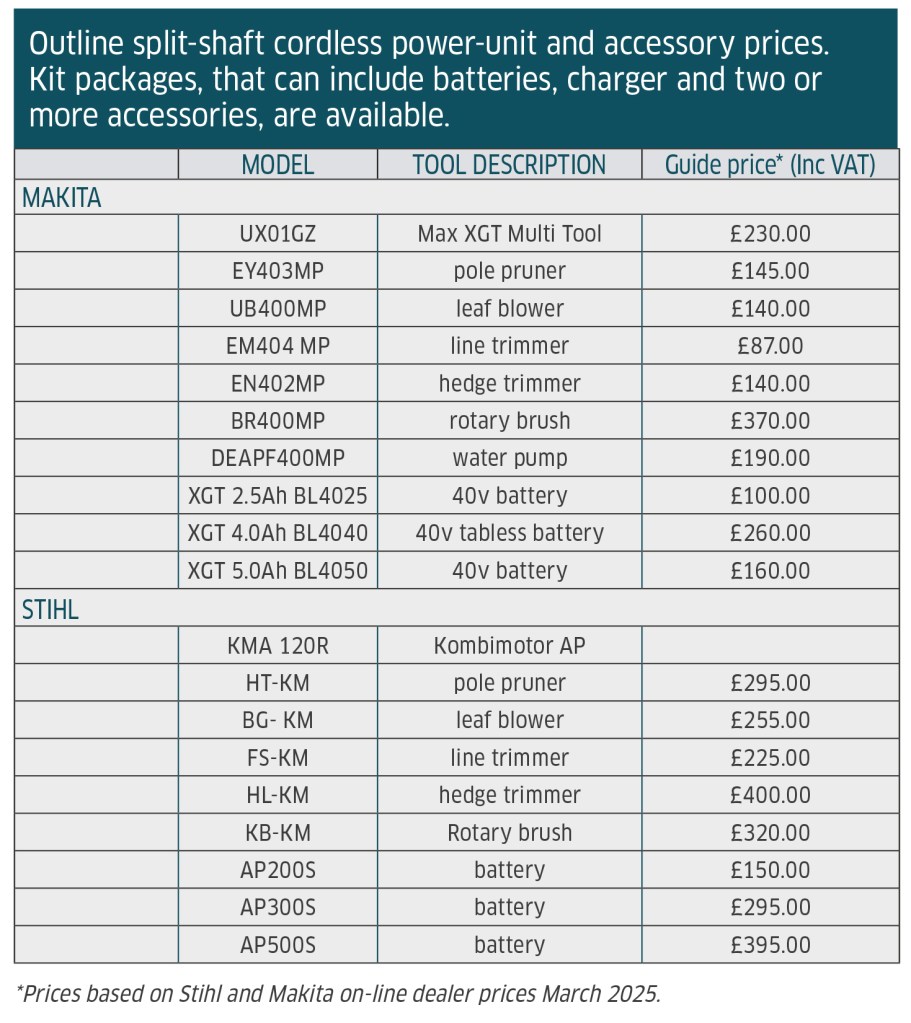
A fair fight?
The goal here is not to directly compare the Stihl and Makita systems. The Makita kit we tested came with two small and light 2.5Ah XGT 40V batteries. These are about the same physical size as a 6.0 amp-hour 18v LXT Makita battery. At 0.69kg, a 2.5Ah XGT battery has a 72Wh power rating. That is ample when used in several XGT workshop tools, such as an angle grinder, impact wrench or drill.
In this outdoor power tool application, however, 72Wh is low when compared to the Stihl AP300 batteries we used. The flip side to this is that an AP battery is physically much larger and heavier. An AP300 battery weighs 1.8kg . The counter point is the battery’s 2.6 amp-hour rating with a total of 227Wh of power (the AP300 is no longer available, the current 7.2 amp-hour AP300 S, now in its third generation, having an improved 281Wh of power). All Stihl AP batteries are the same physical size, regardless of capacity.
It is important to note Watt-hour capacity as this provides a truer guide to how long the battery will continue to give power. Even when compared to physically larger 1.3kg Makita 5.0Ah XGT battery rated at 180Wh, the admittedly larger and heavier Stihl AP300 batteries we used still have much more staying power. As previously outlined, larger 8.0Ah Makita XGT batteries are available but as these are both increasingly heavy and physically larger they will not be the sort of batteries you would want to share with an angle grinder. Even our 5.0 amp-hour batteries feel a bit hefty in these applications. The new BL4040F Makita batteries may make a better choice, but they were not available during our time with the Makita system.
All of this means a direct comparison between the Stihl and Makita systems needs to be balanced between available battery power. As supplied, the Makita UX01G power unit and attached kit was generally lighter with either an XGT 2.5Ah or 5.0Ah battery installed. If a user needs to match the endurance of a Stihl AP system, Makita currently recommends opting for larger batteries carried in belt or back-pack and linked to the power unit via a cable.
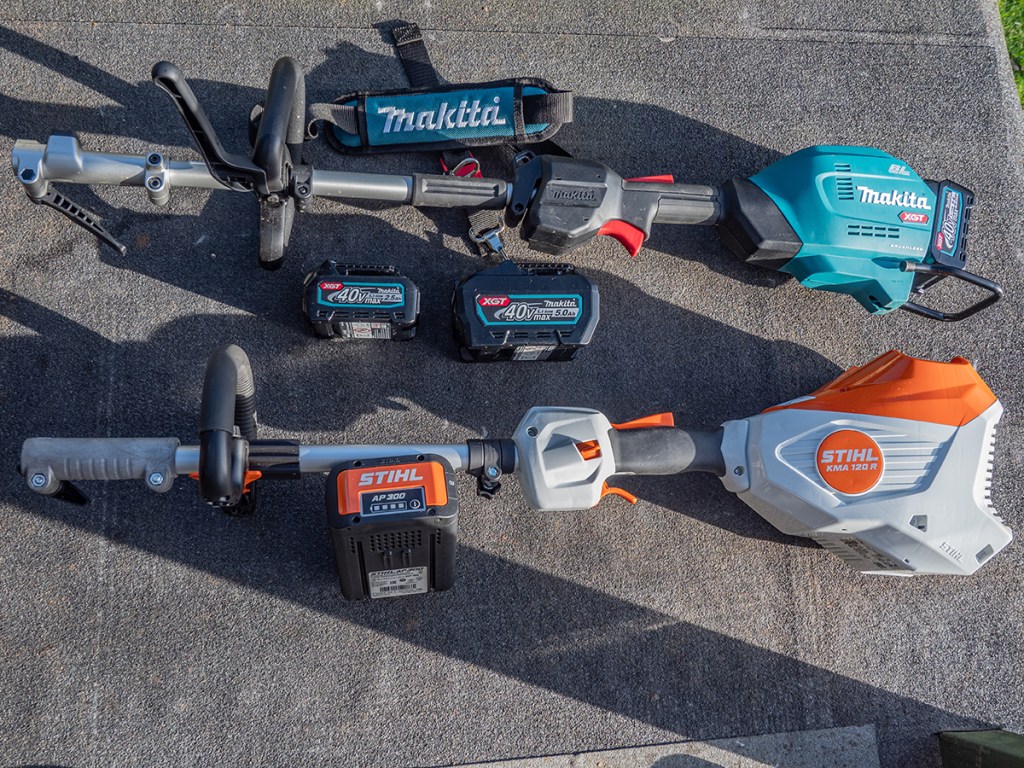
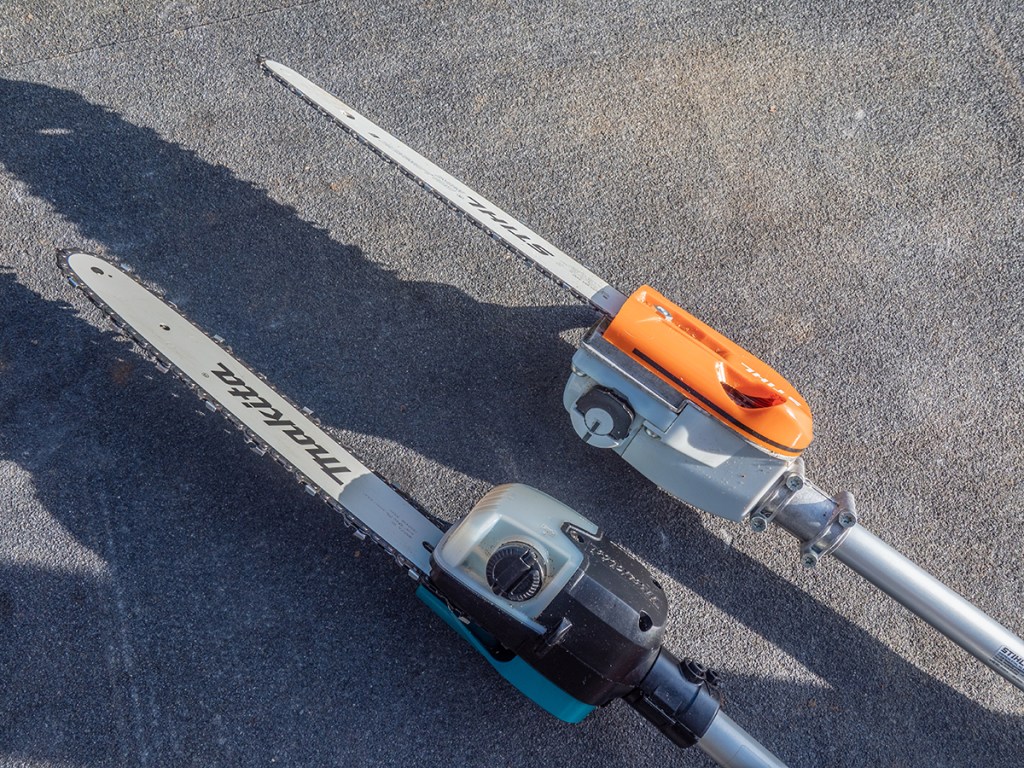
Dedicated tool v split power
Apart from brush cutters / line head ‘strimmers’, our dedicated ‘extended reach’ tool experience is limited to a telescopic hedge trimmer and pole saw. That said, both the Stihl and Makita split-shaft combinations did not feel in any way compromised by their versatile design. Those who use a ‘cow horn’ handle brush cutter with a clearance blade will perhaps be less favourably inclined to opt for the loop handle ‘power heads’ employed here, but Stihl do offer this option within its extensive AP battery Kombi range with Makita also offering alternatives such as its dedicated UR006G ‘bike handle’ brush cutter. The loop handle split-shaft models we tried are available with grass cutting blades to fit the line heads but these designs are not aimed at those seeking a heavy brush cutter for scrub clearance work.
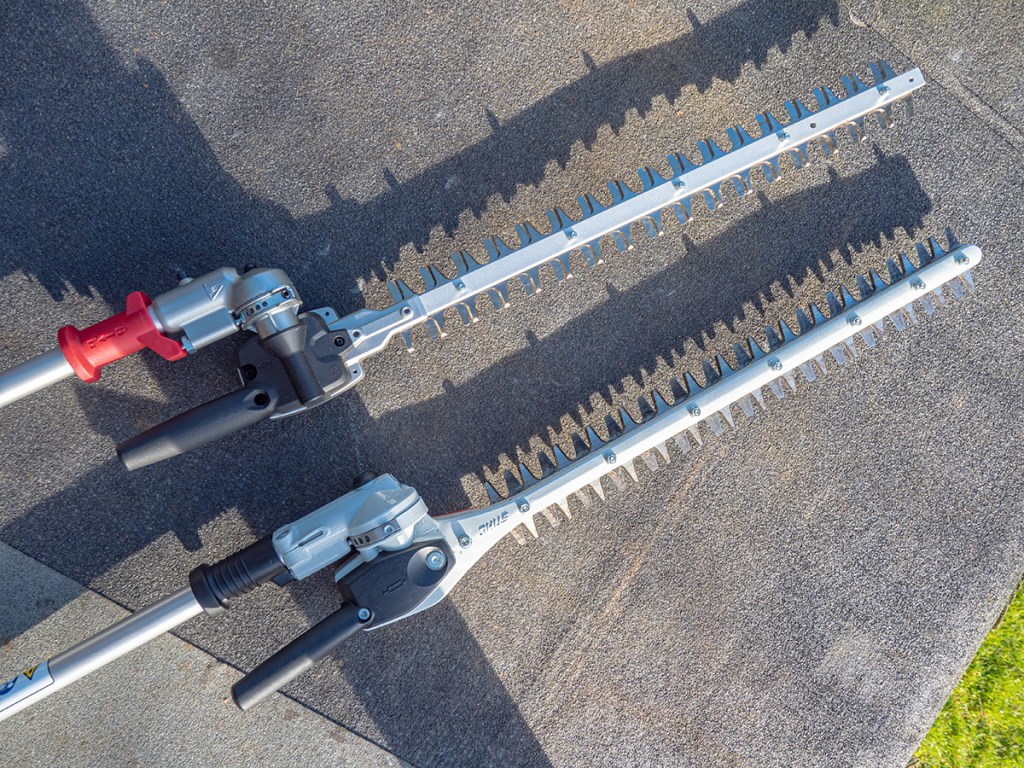

Power pruner, pole saw
Using both systems with their respective pole saw attachments worked extremely well. The Makita was a bit lighter, the Stihl a bit more ‘powerful’ but both tackled everything we threw at them without complaint. The trick was to ensure the chain was sharp and correctly tensioned. It is hard to see the saw head in action from ground level and it is all too easy to tilt the saw head over to one side in work. With a little practice, fast, clean cuts are easily achieved, but you need to let the head follow a straight line.
Both Makita and Stihl supplied nominal 1.0m long shaft extensions. With these fitted to extend the working length the guide bar is further from your sight line and the tools do become somewhat unwieldly, as you would expect. This is countered by the ability to stretch out to around 2.50m. This enables overhanging branches to be tackled safely with both feet firmly on the ground.
We misplaced our Stihl Kombi harness, so we worked it with the strap that came as part of the Makita kit. A strap is necessary in this job as it helps steady the tool in work and spread the weight of the tool as it is manoeuvred into position. Stihl offer a range of strap and body harness designs to work with its Kombi tools and a basic strap should come will all Kombi power units. It is worth considering a body harness system if you are going to use one of these tools for an extended periods with a power pruner or hedge trimmer.
NOTE: The 12in guide bar fitted to these power pruner attachments will happily saw through a 6in diameter branch, but we found it best to resist the temptation to tackle a large branch in one go. Working back to the trunk in short lengths made the job easier and safer, with a much reduced chance of the branch breaking mid cut or the saw head being pinched or trapped. It is also worth topping up the chain lube every time a battery swap is made. It is all too easy to overlook the chain and its condition.
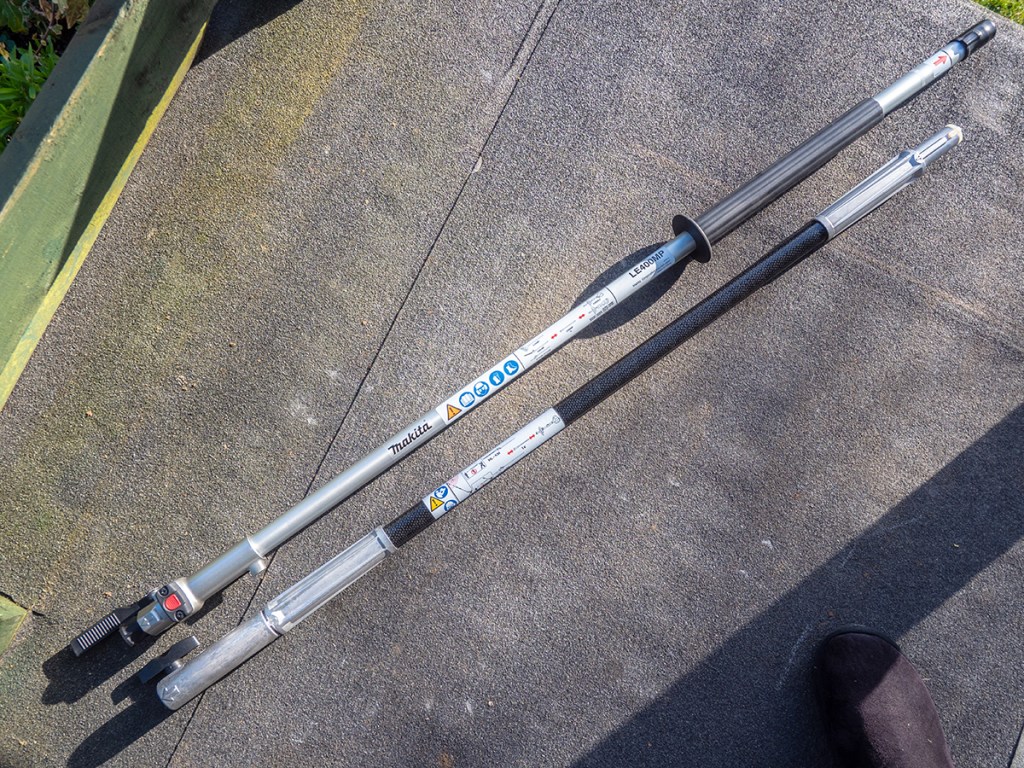
Hedge trimmer
The Stihl HL-KM hedge trimmer attachment weighs in at 2.3kg and can slice a stem of up to around 30mm in diameter. The Makita EN402MP at 2.4kg is a little heavier but we thought it better suited to working on material of up to around 20mm. We tackled a range of vegetation to include a tall hedge comprising a mix of hawthorn, ash, hazel, ivy and willow. We also tackled garden ornamental yew and privet hedges. Both the Makita and Stihl proved handy for tackling regularly maintained hedges, enabling high sections to be trimmed from the ground easily. For low garden hedges we found the length of these tools made them harder to use simply because you must run the tools in the horizontal. If you need to trim a long, low garden hedge a dedicated trimmer would be a better option.
Slotting in the nominal 1.0m pole extensions offered by both Stihl and Makita between the trimmer and power unit can be used to extend the tools reach but again be aware handling this set up is eased if you use a support strap or harness. We found using the extensions with the hedge trimmers tiring.
A point to note is the Stihl blade will fold flush to the shaft for storage, the Makita EN402MP trimmer we used locking out at 90 degrees to the head. Makita offer the EN401MP as an alternative and this will also fold flat like the Stihl.
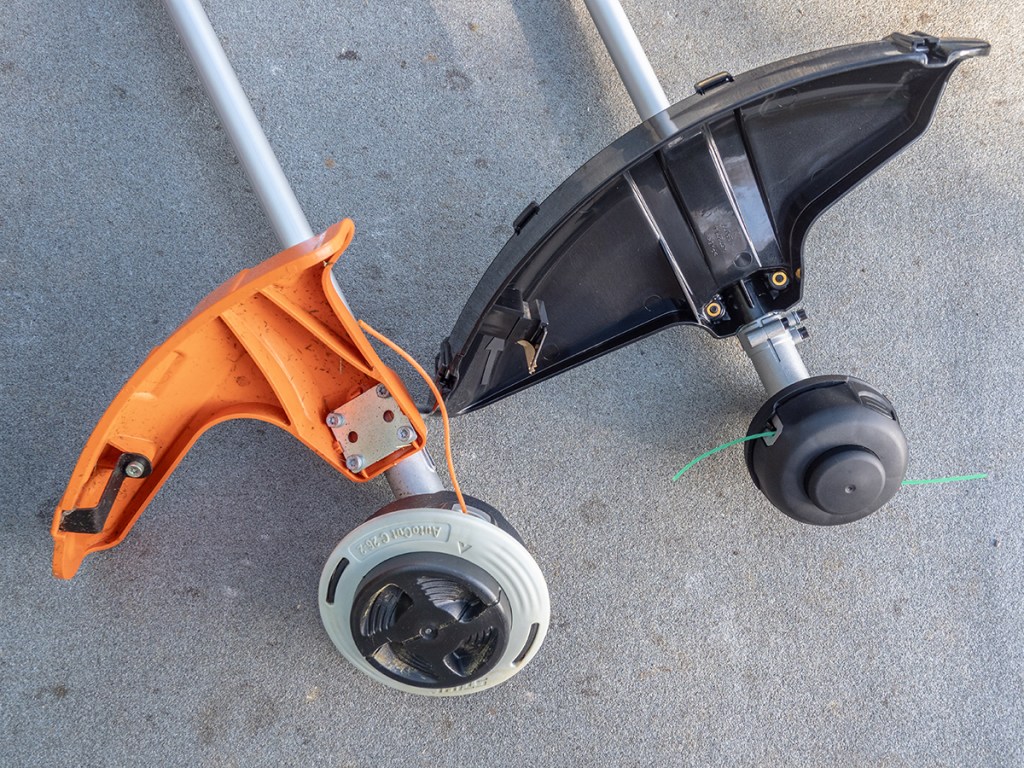
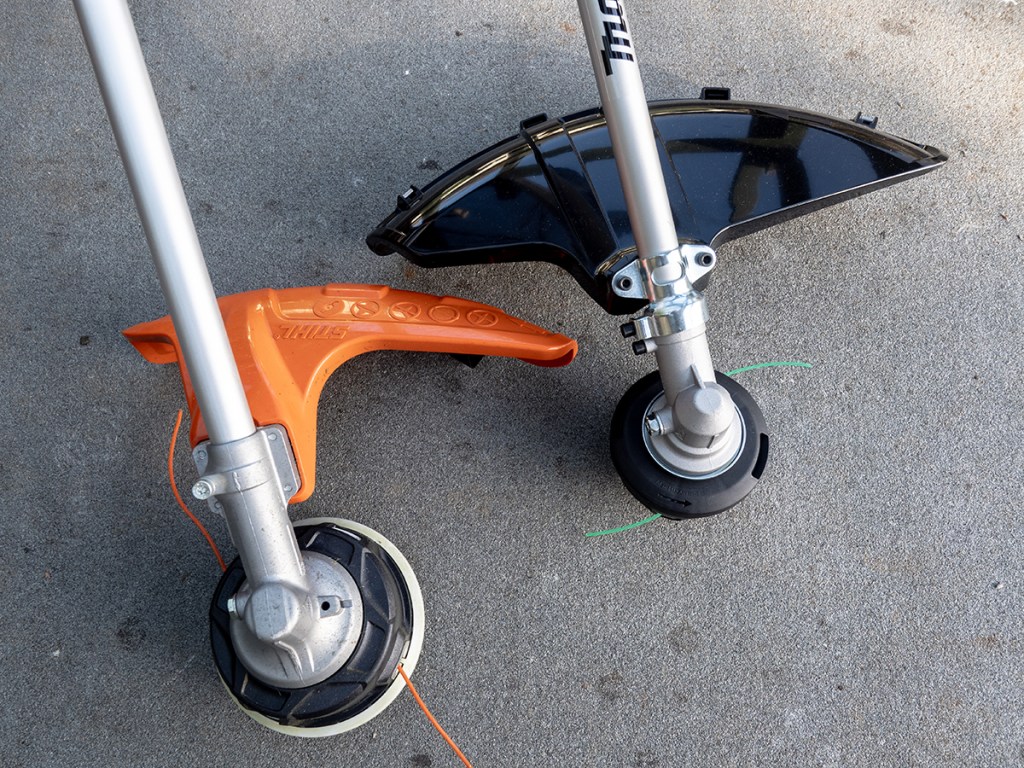
Line trimmer heads
There is a noticeable difference between the Stihl FS-KM and Makita EM404 MP line trimmer units we tried, the latter running a lighter 2.0mm line with conventional bump feed head. Fitting new line involved cutting it to length and winding it onto the feed spool after the latter is removed from the cutting head. The Stihl line trimmer head was supplied with heavier 3.0mm line and fitted with an easy feed system, enabling new line to be wound in without having to take the head apart. A similar system is offered by Makita at under £20 for a direct head replacement.
In terms of performance, the Stihl performed pretty much the same as a nominal 35cc loop handle petrol-powered ‘strimmer’. We found we could run for around 20 minutes before the battery was exhausted in heavy going. The Makita worked well too, but with a 2.5Ah battery it ran out of puff after around 10 minutes in similar going. The 2.0mm line was not as resilient to heavy material but in lighter going it left a good finish. With a larger 5.0Ah XGT battery the Makita ran for up to 30 minutes. With the latest Makita BL4040F tabless batteries, run times, it is suggested, could be improved by as much as 36%.
Both heads can be fitted with grass trimmer blades.
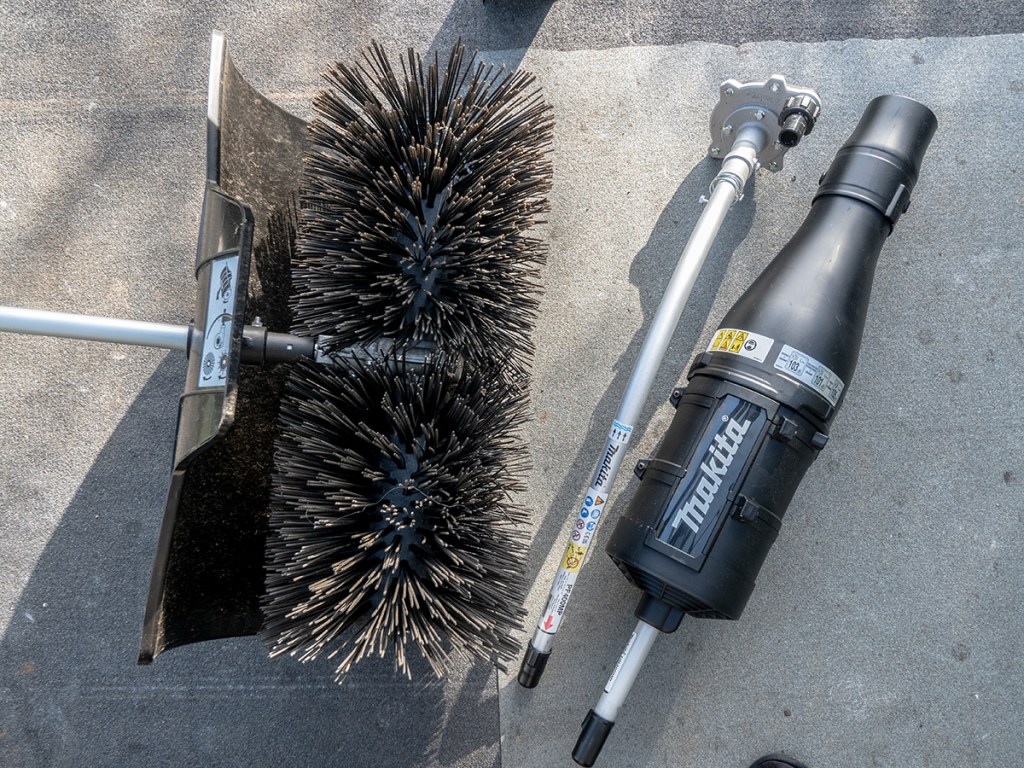
Rotary brush
We have used a rotary brush with a Stihl KM100R petrol-power head and established it takes knack to get the best from these tools. A key point is the bristles of the brush support the weight of tool. When working over a rough surface, such as the tamping lines of coarse concrete, the brush will ‘push’ back hard. You need to lean into the tool to make forward progress. It is best to work along, as opposed to across, the tamping lines where possible. This will also enable the brush to do a better job.
When switching to the battery powered Stihl KMA 120R Kombi, the AP 300 battery delivered enough power but we felt this combination was not that well matched. This was not due to a lack of power but more that the Kombi unit got rather warm and the battery cried enough after just 10 minutes or so. The Makita and its brush attachment saw the 2.5Ah battery give up after a few minutes sweeping coarse concrete. A 5.0Ah battery was much better for this task and lasted for nearer 10 minutes too. In more benign going, such as sweeping the smooth concreate in a grain store, both the Stihl and Makita brush units felt a lot happier and the batteries lasted near double the run time.
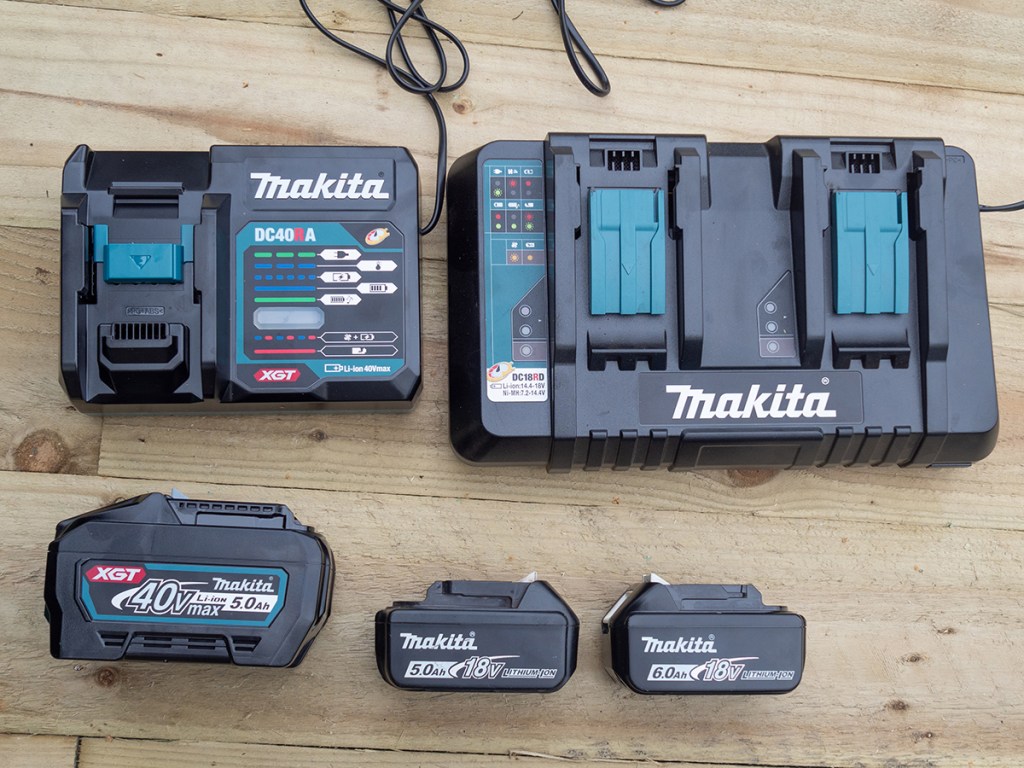
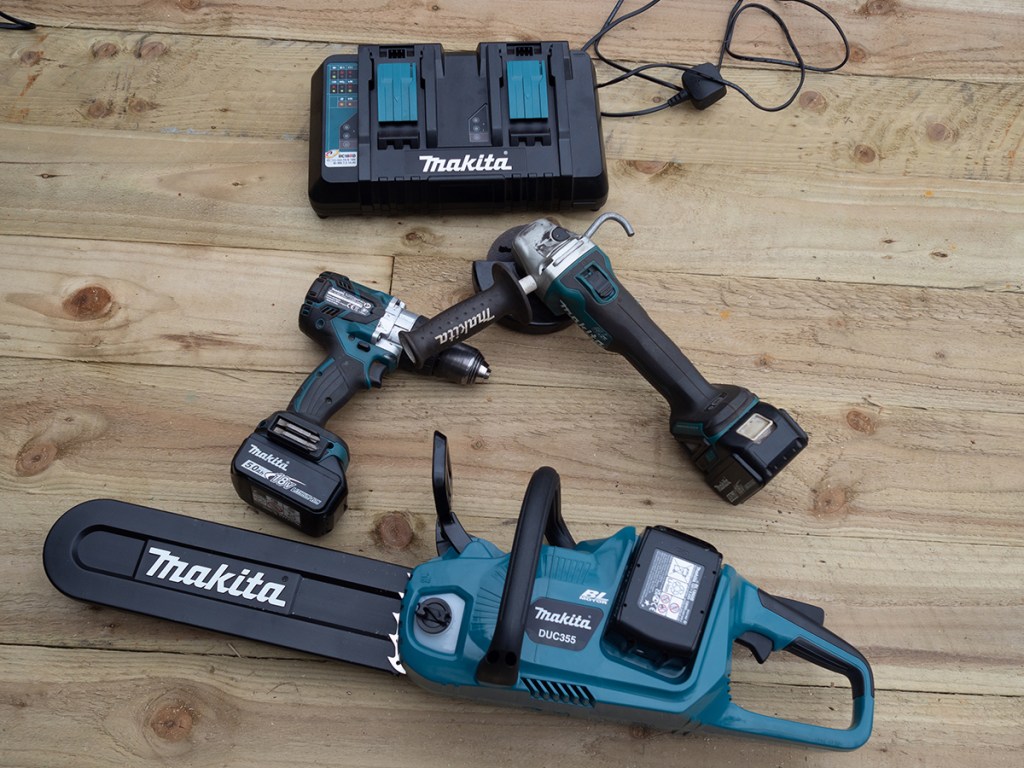
Blower
The Makita UB400MP leaf blower attachment we tried delivers a claimed airflow rate of 50m/s or around 15.5 cubic metres of ‘blowing power’. In work the nozzle of the blower is close to the ground and leaf clearing performance in dry going was good with noise levels considerably better than using the same tools with a petrol-power unit. You still need to wear ear defenders but the sound does not travel in the same annoying way as a petrol blower.
The Stihl BG- KM blower is one we have used for several years and side by side to the Makita it delivered what felt to be similar performance. The difference came with battery run times as a blower will consume a lot of energy at full chat. The AP300 battery was run to flat in about 20 minutes, a Makita 2.5amphour XGT battery crying enough after around 8 minutes, its bigger 5.0 amp XGT brother running for around 15 minutes. Makita offer three other alternative blower attachments to include the lower airflow UB402MP that will be both quieter and less demanding on the battery. Run times with this blower are claimed to be up 30 minutes with an XGT 5.0Ah battery and even longer with the newer tabless batteries.
We used both the Stihl and Makita blowers to blast out debris from under open canopies of a combine, but despite being able to easily reach up higher into the heart of the machine we found both blower combos could be unwieldly due to their length.
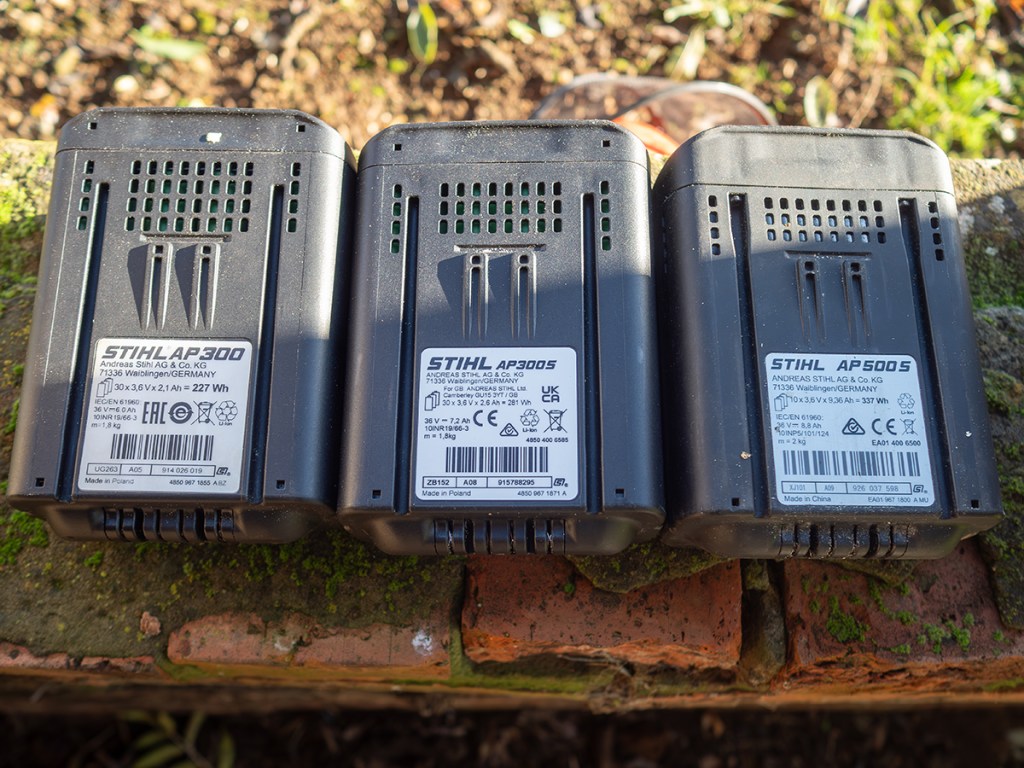
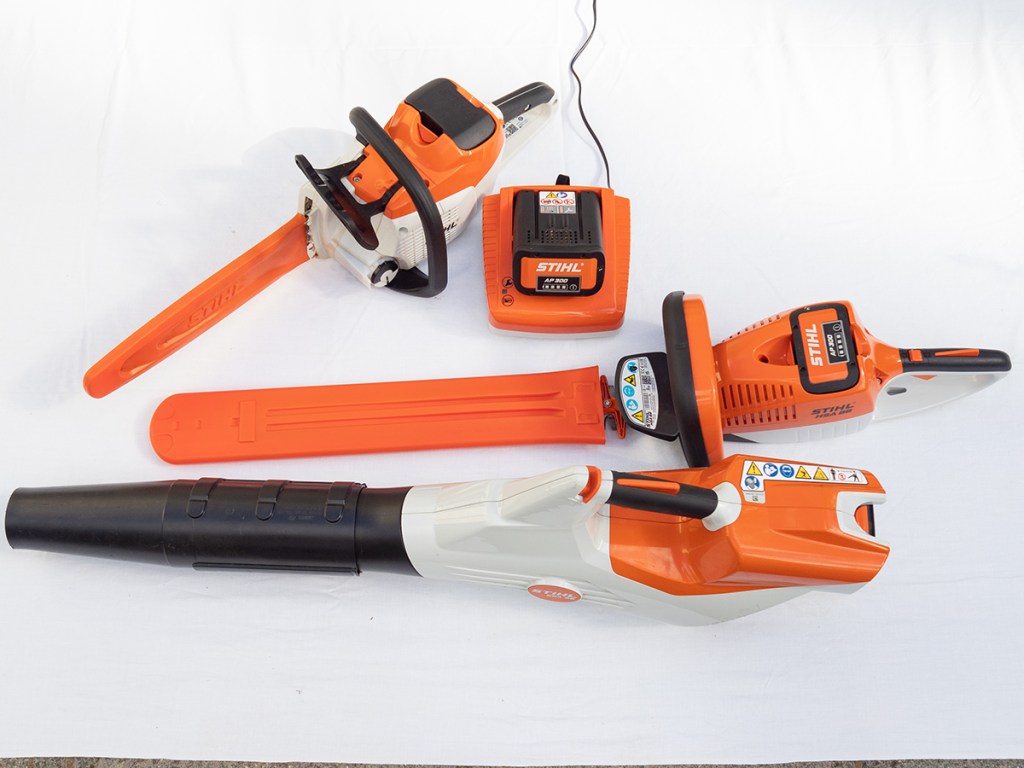
Water pump
Makita suppled a water pump attachment, this having a 25mm outlet that did not fit any of our available hoses runs. As it turned out we found a conventional garden hose would fit inside the coupling. Whilst this no doubt compromised the potential of the pump to deliver its claimed flow of 100 litres per minute, we used it to empty a water trough. This little job took less time than using a bucket until we reached the layer of muck we wanted to clear out.
Initially the pump needs time to prime and we soon learned to keep the unit above the muck at the bottom of the trough to stop it clogging. If you need to clear water in a hurry, such as pumping out rainwater that has flooded a grain pit, a water pump tool will be a great help.
Other tools
The range of attachments to fit the Makita and Stihl power heads is comprehensive, with the same attachments compatible with both battery and petrol-powered systems. Makita and Stihl attachments are not interchangeable, as you would expect.
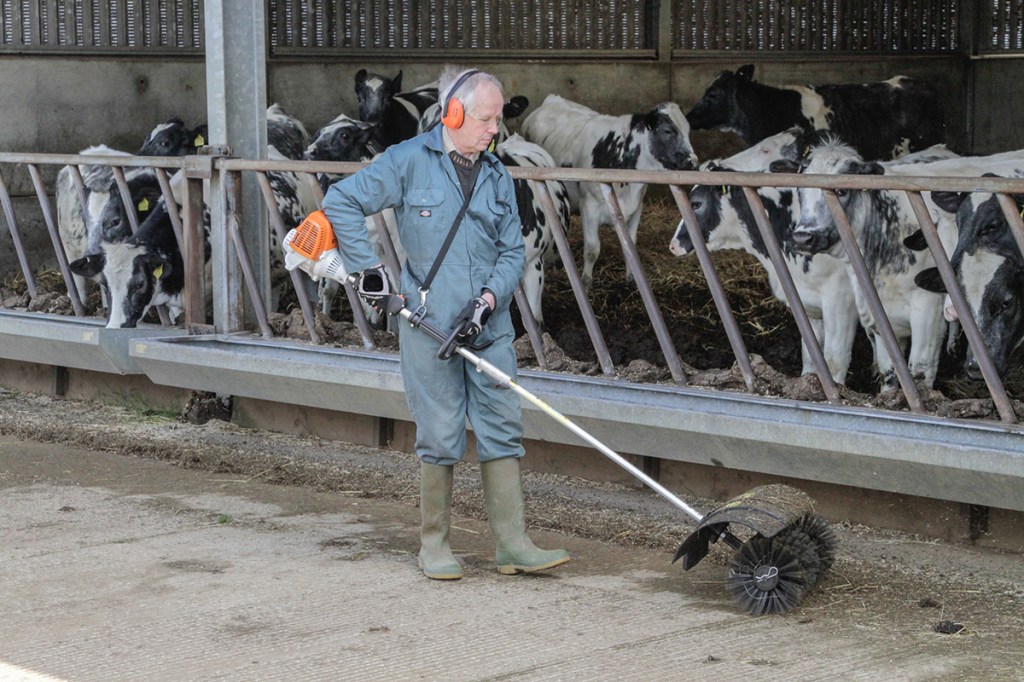
What is a tabless battery?
In brief, a tabless battery eliminates the metal tab connectors used to link a battery’s internal anode and cathode to the external terminals. A tabless battery connects the electrodes directly across their entire edge. This is claimed to produce a more uniform current flow, with reduced electrical resistance, improved thermal management and faster charging and discharging.
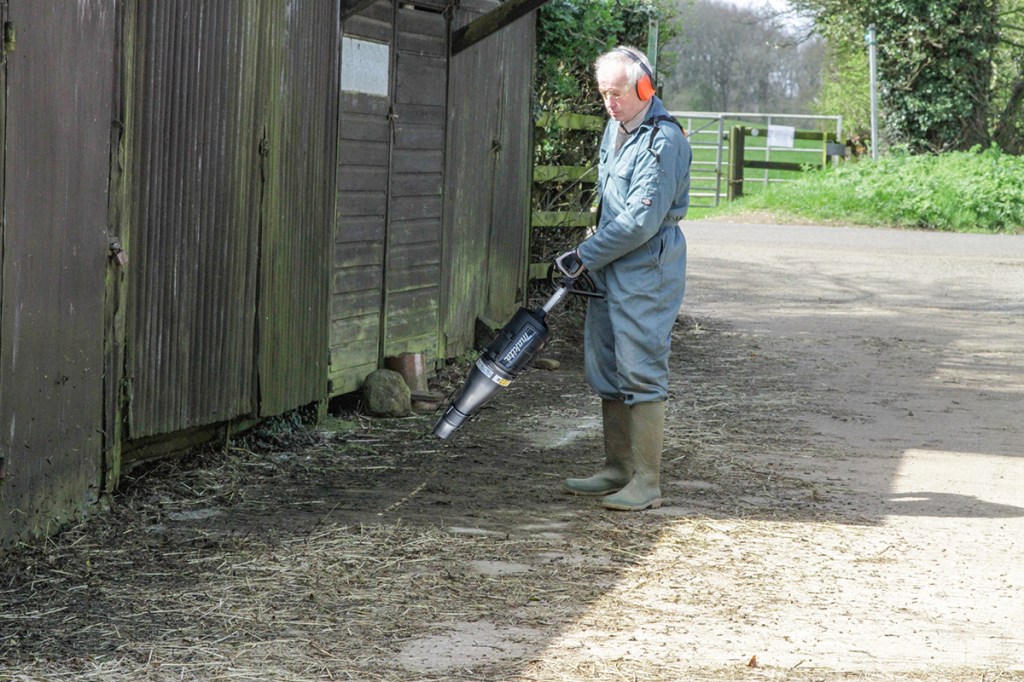
Summary
If you want to share the same batteries with workshop tools, a multi-function power head from companies to include Makita make sense. Our time with the Makita system showed a single XGT battery will deliver the power needed to drive all the accessories supplied with the caveat that a 2.5Ah battery will not have the capacity for a longer run time and is certainly not the battery of choice to run a power brush. Even a 5.0Ah XGT battery found that a tough call. The improved performance for the latest tabless BL4040F batteries could make a big difference, a point to note if you are an existing Makita user.
Although we did not try one, a dual LXT 36v Makita battery power head will also be well worth a look for those using the 18v LXT battery system. The accessories to fit are just the same and they will of course fit a petrol Makita multi-tool power unit, new ‘old stock’ models remaining available from some suppliers.
The Stihl AP split-shaft KMA 120R Kombi battery system is more costly to invest in than a petrol-powered alternative despite this model being at the entry level end of the AP Kombi system. The accessories are, like the Makita’s, designed to work with a range of alternative Stihl Kombi tools, a point to note if you are already invested in a petrol-powered Stihl Kombi system. It is also worth noting that a less costly domestic Stihl AK battery Kombi tool can power the same attachments too.
Now to petrol versus battery power. The latter are, hands down, more pleasant to use. Three stand out plus points include lower noise levels, smooth running and lack of exhaust fumes. In terms of power, both the Makita and Stihl systems we tried delivered pretty much the same performance as the 33cc petrol Stihl Kombi tool we have used for years. The only exception was the power brush, this working well enough with battery power but sucking the batteries dry of power too quickly for anything other than light work.
Regarding run times, a battery powered system will need more than a single battery and the battery capacity you choose will clearly play a big part in how long the tool will run between charges. With the Makita system, you will no doubt share batteries with workshop tools and this will likely determine the size of battery available. With several XGT batteries on hand, you may well find you have enough ‘energy’ stored up for a fair amount of work.
With the Stihl AP system it is different in that the key battery sizes on offer include the AP 500 S. This has a 337Wh of energy sufficient to not just extend run times but also work the more powerful Kombi power heads that are available with ease. The downside? A VAT inclusive retail price not far shy of £400. The plus to that? The battery will soon save that in fuel if used extensively. Overall running costs for battery tools should be lower, with much reduced need for servicing too.
James de Havilland
For more up-to-date farming news click here and subscribe now to profi and save.






